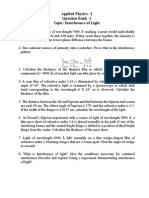Interference
Uploaded by
narenbandaru_iitmInterference
Uploaded by
narenbandaru_iitmProblem Sheet 1 Department of Physics K L University 1. The ratio of intensities of the maxima and minima of interference fringes is 25:9.
Determine the ratio between the amplitudes and intensities of the two interference beams? 2. A parallel beam of light of 6000A is incident on a thin glass plate of refractive index 1.5 such that the angle of refraction into plate is 50. Find the least thickness of the glass plate which will appear dark by reflection. 3. A soap film with a refractive index of 1.33 and thickness of 5000 A is exposed to white light. What wavelengths in the visible region are reflected? 4. What is the thickness of the thinnest film of 1.33 refractive index in which destructive interference of the yellow light 6000 A of a normally incident beam in air can take place by reflection? 5. Find the ratio of intensity at the center of a bright fringe to the intensity at a point one quarter of the distance between two fringes from the center. 6. Two coherent sources whose intensity ratio is 81:1 produce interference fringes. Deduce the ratio of maxima intensity to minimum intensity. 7. A parallel beam of light (= 5890 x 10-8 cm) is incident on a thin glass plate (= 1.5) such that the angle of refraction into the plate is 60. Calculate the smallest thickness of the glass plate which will appear dark by reflection. 8. A drop of volume 0.2 cc is dropped on a surface of a tank of water of area 1 sq.metre. The film spreads uniformly over the whole surface and white light which is incident normally, is observed through a spectrometer. The spectrum is seen to contain one dark band whose centre has wavelength 5.5 x 10-5 cm in air. Find the refractive index of oil. 9. A parallel beam of sodium light strikes a film of oil (= 1.46) floating on water (= 1.33). When viewed at an angle of 30 from the normal, the eight dark band is seen. Find the thickness of the film. 10. In an interference pattern at a point we observe the 16th order max for 1= 6000 A. What order will be visible here if the source is replaced by a light of wavelength 2 = 4800 A.
You might also like
- Interference Diffraction Polarization Fibre OpticsNo ratings yetInterference Diffraction Polarization Fibre Optics8 pages
- 2023-2024 - Assignment-IV Unit-III-Sem I - Wave OpticsNo ratings yet2023-2024 - Assignment-IV Unit-III-Sem I - Wave Optics3 pages
- BPHS0100 Tutorial Sheet1 Interference (even 2024-25)No ratings yetBPHS0100 Tutorial Sheet1 Interference (even 2024-25)1 page
- Bangabasi College Kolkata NPTEL Local Chapter: Problems On OpticsNo ratings yetBangabasi College Kolkata NPTEL Local Chapter: Problems On Optics3 pages
- Applied Physics - I Question Bank - 1 Topic: Interference of LightNo ratings yetApplied Physics - I Question Bank - 1 Topic: Interference of Light28 pages
- YOUNG'S DOUBLE SLIT EXPERIMENT (30-08-2016) (To Be Submitted by 5/6 September 2016) (To Be Submitted in The Tutorial Notebook)No ratings yetYOUNG'S DOUBLE SLIT EXPERIMENT (30-08-2016) (To Be Submitted by 5/6 September 2016) (To Be Submitted in The Tutorial Notebook)5 pages
- Applied Physics - I Question Bank - 1 Topic: Interference of LightNo ratings yetApplied Physics - I Question Bank - 1 Topic: Interference of Light30 pages
- PH101: Engineering Physics Assignment - I InterferenceNo ratings yetPH101: Engineering Physics Assignment - I Interference3 pages
- Unit 2-Optics B.TECH/MBATECH-SEMESTER 1-A.Y. 2022-23 Interference Numerical SolutionsNo ratings yetUnit 2-Optics B.TECH/MBATECH-SEMESTER 1-A.Y. 2022-23 Interference Numerical Solutions9 pages
- IE Irodov Chapter 28 Interference of Light Solutions for JEE Physics PDFNo ratings yetIE Irodov Chapter 28 Interference of Light Solutions for JEE Physics PDF23 pages































































